LISBON’S BEST TAVERNS: THE OLD AND CONTEMPORARY TASCAS
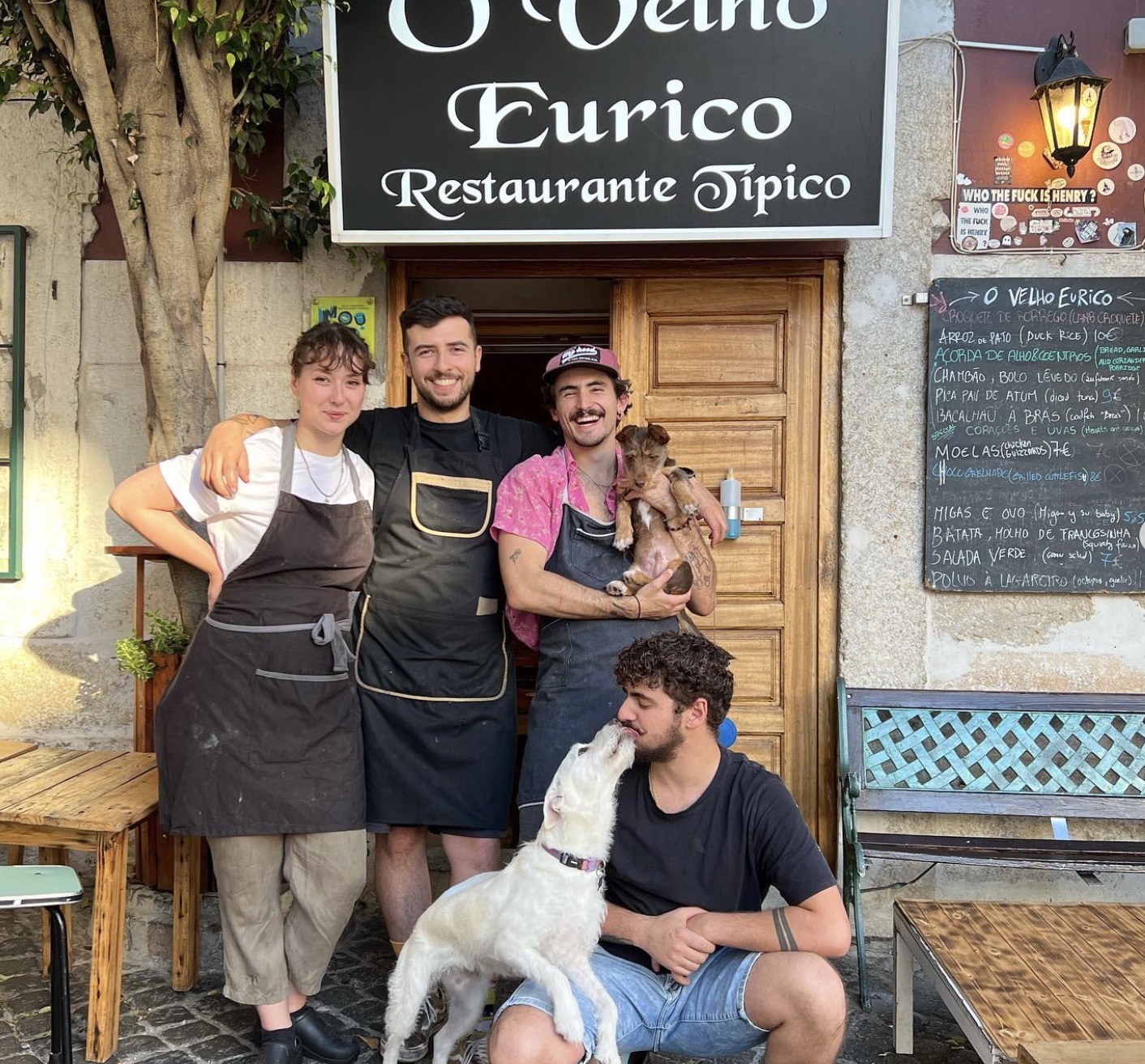
Portuguese taverns, known in the country as tascas, play a major role in the local culinary and social landscape. For centuries, these establishments have served as places for the masses to enjoy affordable food which is highly representative of Portugal’s way of eating, but also as meeting points for the community.
What is a typical Portuguese tasca?
In Portugal, the term tasca signifies much more than its direct translation to English as “tavern”. It represents a long-standing tradition in Portuguese gastronomy, serving as a local eatery where the community gathers to enjoy simple, traditional dishes in a welcoming atmosphere. The evolution of tascas from their inception to their current role in Lisbon’s neighborhoods highlights their importance in fostering social bonds and offering a taste of Portugal’s culinary heritage.
The concept of the tasca has evolved significantly over time. Initially, these establishments functioned as small groceries or wine shops, often attached to coal shops (carvoarias). This was back in the early 20th century, particularly with the influx of immigrants from the Spanish region of Galicia (historically quite humble, thus explaining the heavy presence of Galician-descent individuals, not only in the Portuguese capital, but also in other parts of the world such as Argentina or Venezuela), as well as with the rural exodus that brought many Portuguese folks, like those from the northern Minho region, towards the urban centers, in search of a better life and future possibilities for them and their families. These international and Portuguese migrants, seeking to supplement their income, began serving wine and petiscos (snacks and small dishes) alongside their main business. As Lisbon underwent modernization and the coal industry declined, the focus of these establishments shifted entirely towards food and beverage, laying the foundation for the modern tasca.
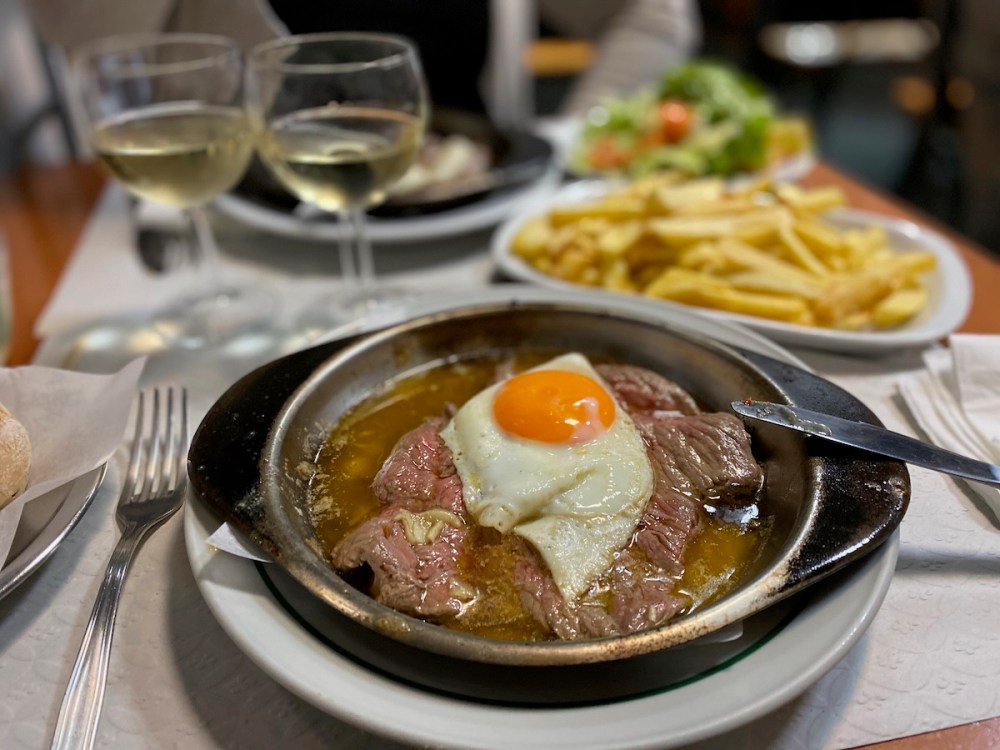
One of my favorite ‘bitoques’ in Lisbon © Sílvia Olivença
Tascas are deeply embedded in the fabric of Lisbon’s neighborhoods, acting as key meeting points for locals and a welcoming space for visitors curious enough to set foot in one of these establishments. These are the types of businesses that we love to take you to during our food and wine tours in Lisbon, in order to directly support places that not only serve delicious food, but that contribute to the identity of Lisbon via very specific and real people (not corporations).
These eateries are typically family-owned. In fact, it is very common to see different family members of at least a couple of generations, in charge of different roles. A common scenario would be for the matriarch to be running the kitchen, for the father figure to be front of house (the taberneiro – often seen behind the counter pouring drinks to regulars and chatting away on the latest political affairs or last night’s football match results), and for the younger generation, maybe the son or daughter, and perhaps even their spouse, to be waiting tables.
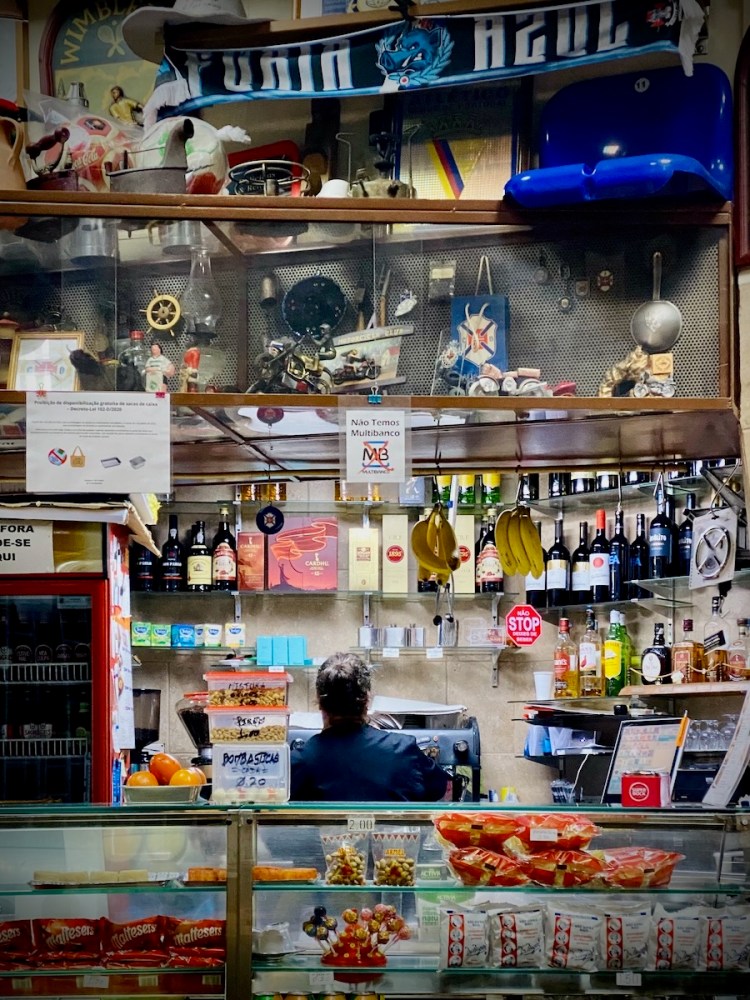
This ‘tasca’ in a residential street near Ajuda, is a visual ‘must’ with well-kept secret ‘bitoque’ (photo taken in 2023) © Sílvia Olivença
The typical menu of a tasca is full of Portuguese classics, ranging from bacalhau dishes, legume heavy concoctions such as feijoada, broad bean stew with Portuguese cured meats or cozido à portuguesa, and grills (more often than not served in metal trays that look the same no matter where you go); as well as hearty comfort dishes, such as rice based recipes, served directly inside the retro looking aluminum pots where they’ve been cooked. While during lunch hours it’d be common for a tasca to serve some daily specials, apart from menu classics such as for instance bitoque (a thin beef steak with a fried egg on top, and a side of rice and fries), for dinner these dishes are often replaced by petiscos, that is, small dishes ideal for sharing as you go through a bottle (or two!) of wine with friends. In the most classic of tascas, wine may even come out of a bigger barrel, often sourced from someone in the family who produces wine in the countryside, very likely in the north of Portugal, and be dispensed in individual glasses or, if we’re really going old-school, even ceramic mugs (known in Portuguese as tigelas or malgas).
The unique appeal of a tasca lies in its distinctive features and the personal touch it brings to dining. Characteristics such as paper tablecloths instead of fabric or, sometimes, even used on top of cloth (apart from doubling as canvases to announce the daily specials, handwritten on the paper and posted by the window shop); displays of boiled eggs in piles of coarse salt; decorations that include photographs of the establishment or the region of Portugal where the owners come from, and which very often is some given town in the northern Minho region; or traditional azulejos that tell the story of the tasca – all of these contribute to the authentic experience! Homemade specialties, often including one salt cod dish and a couple of home-made desserts which regulars would swear by, underline the personal care and tradition which is part of the essence of the tasca.
Beyond their culinary offerings, tascas serve as informal gathering places where people come together to share meals and conversations, reinforcing their role as vital components of community life. Even if you come to dine alone, in many of Lisbon’s tascas you can sit by the counter and chit chat with the staff who’s serving you. Service is usually straightforward yet warm. And even in the cases when servers are a little grumpy or in a hurry (something common during lunch rush), most local customers won’t take offense, as we sort of know this is part of the experience, and good food, great prices, and the brilliant atmosphere more than make up for it!
With menus that feature time-honored dishes and interiors decorated with elements reflective of Portuguese culture, we’d be safe to state that tascas play an essential role in the cultural preservation of Lisbon.
As we go deeper into the world of Lisbon’s tascas, we will explore both the traditional establishments that have been the cornerstone of neighborhoods for generations and the contemporary tascas and taberneiros (folks who run the tabernas), that are reinterpreting traditional concepts for a modern audience.
Lisbon’s traditional taverns
In the dynamic urban landscape of Lisbon, traditional tascas stand as enduring symbols of Portuguese culture and culinary heritage. These establishments, often nestled in the city’s historic quarters, have been the custodians of authentic Lisbon dining experiences, offering a window into the soul of Portuguese gastronomy. The survival of these tascas amidst the whirlwind of gentrification and modernization is a story of resilience and commitment to community values.
The past few decades have seen Lisbon undergo significant transformation, driven by tourism, real estate speculation (especially because of foreign investment, not only of individuals but in great part by big groups which buy entire buildings for luxury residential developments and hotels), changes in rental laws and local political inertia. Areas such as Baixa-Chiado and Cais do Sodré, once amongst the very best areas of Lisbon for traditional dining, have felt the strain of this change the most, leading to the closure of many iconic tascas. One of the most mediatic cases of such a loss was Casa Cid, across the street from the popular Time Out Market, a tavern opened back in 1913 by Galizian immigrants, that managed to stay up and running until just a couple of years ago. Even though it was a successful business, where locals would flock to for lunch and late night bites and drinks, it had to shut down when a real estate company not only purchased the entire building where three generations had already been operating for over a century (with Mr. Borja being the last family figure running the place), but actually bought part of the block, which is currently undergoing renovations to become a luxury hotel.
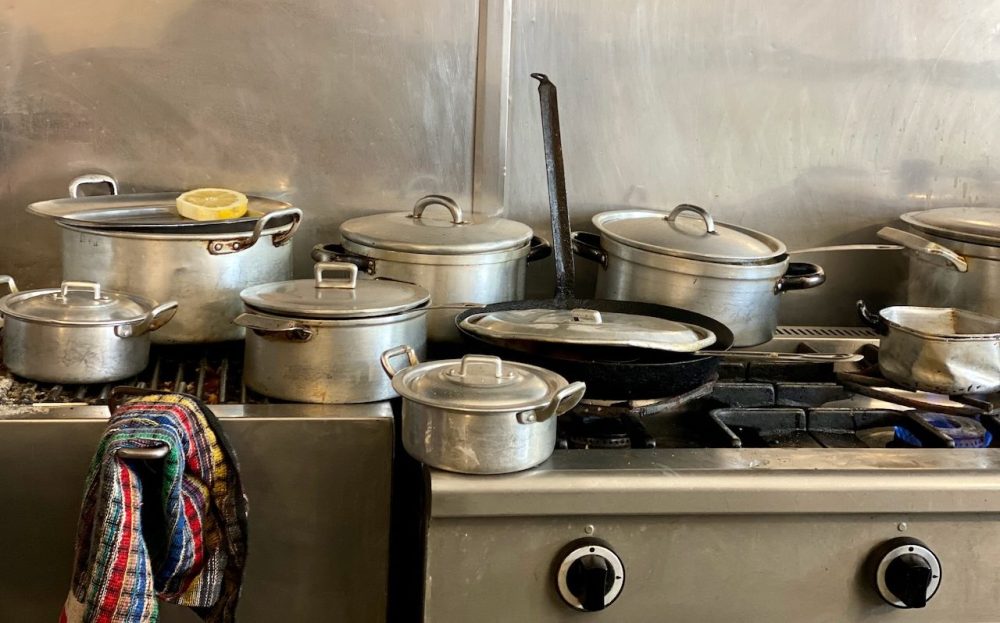
‘A imperial de Campo de Ourique’ AKA Tasca do João © Sílvia Olivença
Already back in 2013, as if announcing the major changes Lisbon was about to go through during the next decade, Adega dos Lombinhos in the neighborhood of Baixa, also closed its doors. Café Estádio in Bairro Alto followed shortly, and so did many others. Places that strongly shaped my memories, my relations, my life, my love for food – we used to sat there for hours and hours – disappear, one by one.
The relentless pace of gentrification has not only altered the physical landscape but also the cultural fabric of these neighborhoods, making it increasingly difficult for traditional establishments to withstand the pressures of rising rents and changing consumer preferences, particularly with the huge influx of international tourism, which isn’t always discerning and often patronizes international chains or, at the very least, restaurants which offer more relatable dining experiences, whether it’s because of their menu or simply because of the overall communication style of the brand.
Despite these challenges, some tascas have managed to survive and even thrive, thanks to a combination of factors. Location plays a critical role, with tascas in less tourist-centric neighborhoods like Benfica, Alvalade, or Carnide (just to name a few) finding a more stable footing. These areas have been somewhat shielded from the intense pressures of gentrification, allowing tascas to maintain their role as traditional food providers, as well as community hubs.
Moreover, the enduring appeal of traditional tascas lies in their ability to offer a genuine taste of Portuguese culture. These establishments have remained true to their roots, serving classic dishes that resonate with both locals and informed travelers seeking authentic experiences. The personal touch of family ownership, often passed down through generations, contributes to the unique charm and authenticity of each tasca, fostering a loyal customer base that values tradition over trend. Because we often don’t know what we have until it’s gone, the shutting down of some of the city’s most iconic tascas has resulted in a newfound appreciation for these types of establishments by lisboetas, who now make it a point to seek the experiences only a true tasca can provide, while supporting their longevity. Furthermore, some of these establishments are also protected under the program Lojas Com História, which is a municipality initiative which supports the businesses (not limited to F&B shops, but also including all other sorts of establishments too) that have historically contributed to Lisbon’s identity and that we hope they continue to do, independently of their mere economic success.
These are some of Lisbon’s tascas that have remained relevant and vibrant in Lisbon’s ever-evolving dining scene:
A Tendinha do Rossio
If there is one true example of Lisbon’s tavern culture, with all of its simplicity and charm, A Tendinha do Rossio is it! It proudly holds the title of the city’s oldest running taberna, since 1840. Nestled in the bustling heart of Rossio, right downtown, it offers passersby a window into a bygone era.
Alfredo Gramaça, the tavern’s longest-serving employee, embodies the spirit of A Tendinha do Rossio. A native lisboeta from Madragoa, his wide smile and commanding presence behind the bar have been a staple for a quarter century already! Alfredo serves food and manages the constant flow of drinks, such as vinho verde, draft beer, ginjinha Eduardino (a local traditional cherry liqueur), paired with iconic straightforward foods that have remained unchanged for decades: codfish cakes, sandwiches with presunto (cured ham) or filetes de pescada (haddock filets), bifanas (juicy pork), breaded cutlets, and more. All at super affordable prices!
This tendinha is a rare gem that captures the essence of the old-school tavern spirit, offering a glimpse into the past while serving up timeless flavors that continue to delight locals and which, more and more, foodie travelers also embrace.
A Tendinha do Rossio is such an iconic establishment that there is even a fado song from 1930 called “Velha Tendinha”, which sings about the good ‘ol bohemian days of Lisbon, which often involved downing one too many drinks around here. The fado literally says “a shabby and ordinary-looking little shop” and, at least today, we would take every single one of these words as a compliment!
We sincerely hope that A Tendinha do Rossio keeps going, always embracing authenticity… otherwise, where else are we going to enjoy a fish sandwich and a mug of green wine for less than 5 euros, while thinking about all of the famous Lisbonites that have also drowned their sorrows or soaked up the excess alcohol in their system right here?!
📍Praça Dom Pedro IV 6, 1100-200 Lisbon
No website or social media presence… after all, this is the ultimate old-school tasca of Lisbon!
Merendinha do Arco
Also known as A Merendinha do Arco Bandeira, this is a neighboring business of A Tendinha do Rossio above. They’re all about good food, served well (honoring their slogan which reads “Hygiene, Honesty and Speed”), in a setting that feels like home.
Merendinha do Arco was established by a Galician entrepreneur in 1944, opposite the famous Rossio animatograph. This restaurant has witnessed the evolution of Lisbon from an era of horse-drawn carriages to the bustling city it is today. Now, for the past 14 years, it has been under the management of David Castro, a Minho native, with the culinary magic attributed to his wife, Fátima. But despite changes in ownership, Merendinha do Arco has retained its essence as a true tasca, complete with an aluminum counter, where you can still today enjoy a glass of house wine and a sandes de patanisca, that is, flat codfish fritters tucked inside a bread roll.
The allure of Merendinha do Arco lies not just in its delicious dishes but also in its atmosphere, which captures the quintessential tasca vibe. The commitment to serving hearty, satisfying meals at affordable prices ensures its popularity. Because of their stellar hearty dishes and warm service, we think this is a must-visit for anyone seeking an authentic Lisbon tasca experience – note that they do not open for dinner, but they do serve lunch all throughout the afternoon!
📍Rua dos Sapateiros 230, 1100-581 Lisbon
Cardoso do Estrela de Ouro
Cardoso do Estrela de Ouro has been a cornerstone of the Graça neighborhood since 1909. Even though Graça has succumbed to the waves of gentrification in recent years, Cardoso doesn’t seem to have noticed yet, and we couldn’t be happier about it!
This beloved eatery is right beside the historic working-class district of Estrela de Ouro, which was founded in the early 20th century by the notable Lisbon entrepreneur Agapito Serra Fernandes. Because this tasca has remained untouched by time and trends, acclaimed chef Nuno Mendes highlighted it in his evocative book “My Lisbon: A Cookbook from Portugal’s City of Light”.
The essence of Cardoso do Estrela de Ouro is encapsulated by its host, Mr. Cardoso, whose welcoming presence and namesake define the establishment. The space, cozy and corridor-like, with tables neatly arranged between the wall and the counter, invites a loyal clientele who come for the hearty lunches and the warm atmosphere that Mr. Cardoso orchestrates, ensuring everyone feels at home.
Noted for its exceptional offering of caracóis (snails) during their season, Cardoso do Estrela de Ouro is a trusted destination for those in pursuit of this delicacy, but also other traditional dishes that rotate daily. The selection includes staples like bacalhau com grão (cod with chickpeas), bacalhau à lagareiro (baked cod with olive oil and garlic), pastéis de bacalhau com arroz de feijão (codfish fritters with kidney bean rice), dobrada (a traditional pork and bean stew), cozido (Portuguese stew), and cabidela (a rich rice dish made with poultry blood).
In an area like Graça, where the rapid pace of gentrification has transformed the neighborhood and keeps doing so, to say that Cardoso do Estrela de Ouro is a gem is a massive understatement – this place is a cultural relic!
📍Rua da Graça 24, 1170-270 Lisbon
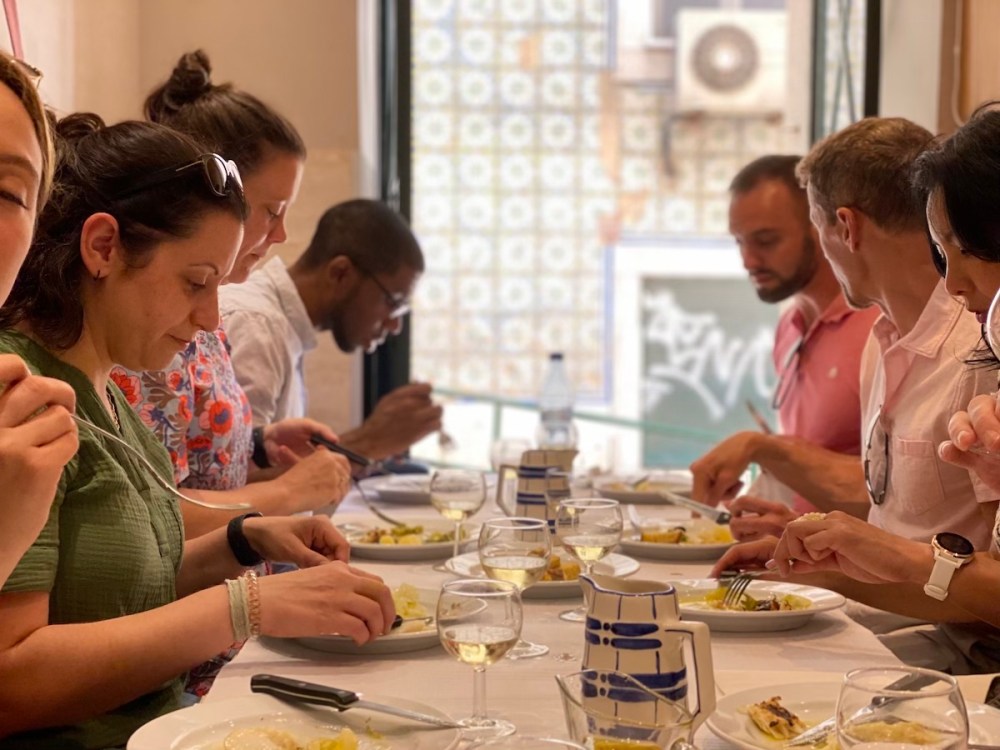
Zé dos Cornos long table with dishes filled with grilled cod, olive oil and garlic © Sílvia Olivença
Zé dos Cornos
Zé dos Cornos has long been celebrated for its genuine Lisbon tasca experience. It draws its unique name from an intriguing interior decoration choice made by José Ferreira, the father of the current proprietor, João, who literally put some horns (that’s what the Portuguese word cornos means) on the wall.
This family-owned establishment traces its roots back to Ponte de Lima in Minho and has evolved from a charcoal shop (the carvoarias we were mentioning above) into the cherished tasca it is today. Originally a place where locals could warm their meals over charcoal and enjoy simple pleasures like wine, cheese, and fried fish, Zé dos Cornos transitioned into a tasca still under João’s father. Today, João continues the legacy, enriching the lives of patrons with traditional Portuguese cuisine.
While the warmth and friendliness of João add to the charm of Zé dos Cornos, at the end of the day regulars come here for the good food, namely their signature roasted cod, as well as the entrecosto, that is, the grilled ribs.
📍Beco Surradores 5, 1100-591 Lisbon
A Provinciana
More than a tavern, A Provinciana is a piece of Lisbon’s history, with its roots stretching back to the 1930s. Originally founded by Galician immigrants, the establishment was taken over by Mr. Américo in 1988. Before embarking on this venture, Américo had worked at one of Rossio’s famed ginjinha (sour cherry liqueur) houses, bringing with him a passion for hospitality that has defined A Provinciana ever since.
One of the most captivating aspects of A Provinciana is its unique décor, primarily the extensive collection of clocks that adorn its walls, a testament to Américo’s hobby. These clocks, crafted from various materials such as barrel lids, plate bottoms, and tiles, turn the tavern into a veritable museum of timekeeping.
In the kitchen, D. Judite, Américo’s wife, prepares the house specialties, which include bacalhau à minhota (Minho-style fried cod), caldeirada de bacalhau (codfish stew), chanfana (goat stew), feijoada (bean stew), dobrada (tripe stew), and the highly anticipated cozido (Portuguese stew) on Thursdays. It’s the combination of these delicious offerings and the family’s warmth that keeps the tavern bustling.
A Provinciana’s history can be traced back to the days of José Gonçalves Estevez and later his widow, from whom Américo Fernandes purchased the business. Located near the iconic A Ginjinha (Espinheira), it is recognized as a Loja Com História (Store with History). We think that, for as long as they keep serving wine directly from the barrel, a practice that dates back to its earliest days, the history will be alive!
📍Tv. do Forno 23, 1150-193 Lisbon
www.facebook.com/RestauranteAProvinciana

‘Senhor João’ who’s behind the name which this establishment is colloquially known as: Tasca do João © Sílvia Olivença
Imperial de Campo de Ourique
Imperial de Campo de Ourique, another distinguished Loja com História, encapsulates the essence of traditional Portuguese hospitality, significantly enriched by the magnetic personality of its host, Mr. João, who’s behind the name which this establishment is colloquially known as: Tasca do João.
Imperial de Campo de Ourique’s story predates its existence as a tavern. From 1920 to 1942, it served as the first headquarters of the Campo de Ourique Volunteer Firefighters. It officially opened as a tavern in 1947 and was taken over by the current managers, João Gomes and his wife Adelaide Fernandes, in 1985. Since then, any changes to the premises have been made strictly to comply with legal requirements in food safety and occupational health, with a clear aim to preserve the building’s original and genuine character. This is quite a rare find in Lisbon!
The culinary delights at Imperial are crafted by the skilled hands of D. Adelaide, with specialties like cabidela, moelas (chicken gizzards) and the excellently prepared bacalhau à minhota – reflecting their team’s Minho origins and sense of pride. To wash it all down, João sources the wine from Arruda dos Vinhos, where his family resides.
Come eat at Imperial de Campo de Ourique to enjoy a journey back in time, while also taking your taste buds to the Minho region, which is an incredible area of Portugal when it comes to rich culinary heritage and dedicated sense of hospitality.
📍Rua Correia Teles 67, 1350-095 Lisbon
www.facebook.com/ImperialCampoOuriqueTascadoJoao
The survival of these tascas (which are just some examples to kick-start your explorations in Lisbon and by no means intended to be an exhaustive list) amidst the forces of modernization and gentrification, is a testament to the resilience of tradition and the enduring value of authenticity in the face of change.
The contemporary tascas of Lisbon
As Lisbon evolves, so too do its tascas. The city’s contemporary taverns are manifestations of the adaptability and enduring appeal of this traditional dining concept, blending the old with the new to meet the tastes of today’s diners.
In the face of Lisbon’s rapid urban transformation and shifting culinary trends, some traditional tascas have chosen to adapt, undergoing significant revamps that respect their heritage while embracing modern dining expectations. These updated tascas maintain core elements, such as a focus on Portuguese cuisine, particularly the nose-to-tail eating philosophy that utilizes the whole animal, and a relaxed atmosphere that fosters social connections. Yet, they introduce contemporary touches in decor, menu design, and service style, aligning with the preferences of a new generation of patrons as well as the international clientele.
Conversely, a new wave of tascas has emerged, founded with the contemporary diner in mind. These establishments, while modern in inception, pay homage to the tasca tradition by offering dishes deeply rooted in Portuguese culinary traditions but presented with a modern twist. The ambiance in these tascas blends the informal, convivial spirit of the traditional tavern with sleek, contemporary design elements, creating spaces that are both inviting and, sometimes, even stylish (a word you’d be hard pressed to see in the same sentence as tasca until not that many years ago).
What sets the contemporary tasca apart from other bars or restaurants is not just the menu but the entire dining experience. The ambiance is deliberately casual, yet with an attention to detail that elevates the dining experience without sacrificing the warmth and accessibility of traditional tascas. Food and drinks remain quintessentially Portuguese but are often reimagined through creative presentations or innovative combinations, appealing to both local and international palates.
Social dynamics in contemporary tascas also differ. While still serving as social hubs, these modern establishments often attract a diverse crowd, from local foodies to international tourists, all drawn by the promise of experiencing authentic Portuguese cuisine with a modern touch. We believe that, by embracing both tradition and innovation, contemporary tascas play a crucial role in the preservation and evolution of Portuguese culinary traditions. They serve as bridges between the past and the future, ensuring that the essence of the tasca (its focus on community, simplicity, and culinary excellence) remains relevant in today’s fast-paced world. Moreover, these modern taverns contribute to the dynamism of Lisbon’s dining scene, offering new reasons for locals and visitors alike to explore and fall in love with Portuguese cuisine.
These are some of Lisbon’s best contemporary tascas, that honor the past while eagerly embracing the future, as they offer a dining experience that is rich, varied, and deeply rooted in the Portuguese way of life:
Taberna Rua das Flores and Quiosque de São Paulo
Founded in the heart of Lisbon’s vibrant Chiado district, Taberna Rua das Flores established a milestone in the evolution of the city’s tascas. This establishment quickly distinguished itself with its unique focus on storytelling through food. Each dish served is not just a meal but a narrative, exploring the depth and diversity of Portuguese cuisine while paying homage to its rich history and regional variations, as well as the connections that Portugal and portuguese cuisine have with other parts of the word, namely the former colonies or regions that the Portuguese had contact with during past centuries.
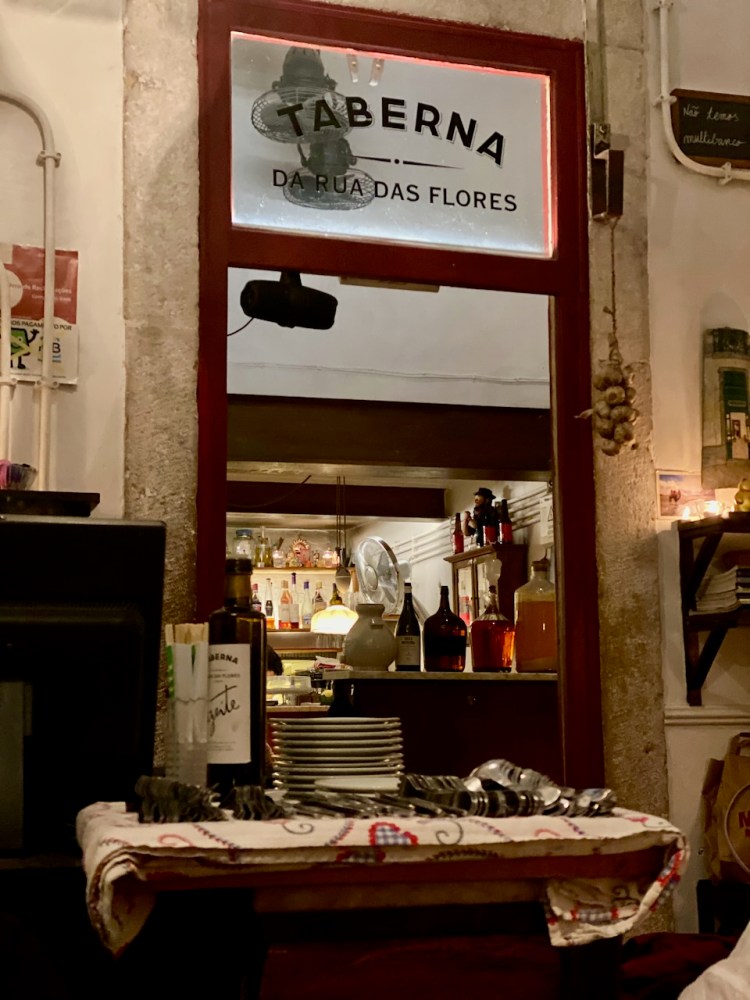
Taberna da Rua das Flores, before its extension, in 2024. © Sílvia Olivença
The taberna‘s philosophy centers on a profound respect for the culinary arts, marrying traditional techniques with modern culinary trends to create a dining experience that is both authentically Portuguese and refreshingly innovative. The menu features a rotating selection of dishes that highlight the best of what the season has to offer. From savory petiscos that invite sharing and conversation to hearty main courses that satisfy the soul, the taberna excels in creating flavors that are both familiar and surprising.
This establishment has not only delighted diners but, through the figure of its owner and chef André Magalhães, aka Mestre André, is has also served as an inspiration for a new generation of taberneiros, influencing notable figures such as Zé Paulo Rocha of O Velho Eurico (see below). The success of Taberna Rua das Flores demonstrates the potential for traditional tascas to evolve and thrive in the modern era, setting a standard for others to follow.
In addition to its flagship location, the essence of Taberna Rua das Flores extends to Quiosque de São Paulo, a unique outpost that offers a taste of the taberna‘s culinary creations in a more casual, outdoor setting. Situated in the lively São Paulo area, the quiosque provides a relaxed environment where guests can enjoy signature dishes and drinks from the taberna, and others created specifically for this even more relaxed setting.
📍Rua das Flores, 1200-195 Lisbon
www.instagram.com/tabernadasflores
📍Largo de São Paulo, 1200-425 Lisbon
www.instagram.com/quiosque.saopaulo
O Velho Eurico
Within the steep streets that meander between Sé de Lisboa (Lisbon’s cathedral) and São Jorge’s castle, O Velho Eurico shines as a modern example of tasca culture. Since its inception about half a decade ago, it has become a phenomenon in Lisbon’s dining scene, celebrated for its unique blend of traditional tasca ambiance with innovative culinary practices. Under the leadership of chef Zé Paulo Rocha, O Velho Eurico has redefined the tasca experience, staying true to its slogan “Uma taberna, com taberneiros” – a tavern with tavern-keepers.
Zé Paulo Rocha, back then at the youthful age of 25, embarked on a culinary journey deeply influenced by his family’s Minho heritage and their extensive experience in Lisbon’s restaurant scene. His formative years were spent amidst the hustle and bustle of his family’s restaurant, where his passion for cooking and the restaurant business was nurtured. Rocha’s culinary path took a significant turn during his tenure at Sal Grosso (more on this eatery below), a pivotal experience that steered him towards embracing and innovating within the realm of traditional Portuguese cuisine.
O Velho Eurico, previously known as Eurico Casa de Pasto, carried the legacy of a tasca that had served Lisbon’s locals for decades. When Rocha took over the establishment in August 2019, he was faced with the challenge of preserving its storied name while injecting a fresh perspective into its offerings. This transition was not merely about changing hands but about reviving and enhancing a beloved institution. The pandemic posed further challenges, yet through resilience and innovative strategies like takeaway services and very cool marketing and digital communication, Rocha and his team managed to strengthen their connection with the local community, previously overshadowed by the influx of tourists.
At the core of O Velho Eurico’s success is its uncomplicated yet profound culinary philosophy: honoring the essence of traditional dishes without succumbing to the lure of unnecessary innovation. Rocha and his team approach each recipe with a blend of reverence and creativity. This balance ensures that every dish, while familiar, offers a new narrative, a fresh experience that resonates with both long-time residents and newcomers to Lisbon. O Velho Eurico critical acclaim and a loyal following, is evident in the month-long wait for dinner reservations. When (and if) you manage to secure a reservation, simply do not miss their bacalhau à Brás, which is one of Lisbon’s most celebrated dishes and, how it’s here reinvented, perfectly embodies the spirit of contemporary tasca we’ve been trying to convey.
📍Largo São Cristóvão nº3, 1100-179 Lisbon
www.instagram.com/ovelhoeurico
On the next video, apart from Oh! My Cod intervention, you can also hear Zé Paulo Rocha elaborating about one of their best achievements: the ‘bacalhau à brás’!
Taberna Sal Grosso
Situated in the quaint neighborhood of Santa Apolónia, very near the historic Alfama district, Sal Grosso is another pivotal establishment in Lisbon’s contemporary tasca scene.
Originally making waves for its simple yet exceptional culinary offerings, dedicated service, and the palpable camaraderie between the staff and patrons, Sal Grosso faced temporary closure due to the pandemic. In 2021, the torch was passed to new management under the stewardship of chefs Jorge Melgas and Luís Pimenta, who were determined to bring Sal Grosso back to its former glory. Their efforts have paid off, turning the 25-seat tavern into one of Lisbon’s most sought-after dining spots once again.
The founding chef, Joaquim Saragga Leal (who is meanwhile behind the stove at Taberna Os Papagaios – Rua Lucinda Simões 13), left a lasting mark on Sal Grosso, after he decided to leave during the Covid19 pandemic. After his departure, longtime admirers and seasoned chefs, Jorge Melgas and Luís Pimenta, took up the mantle. Their background in prestigious culinary establishments across Portugal and abroad brought a fresh perspective to Sal Grosso while preserving the essence that made it a staple in Lisbon’s dining culture.
Sal Grosso focuses on dishes that encourage sharing and social dining. The chefs have kept some of the restaurant’s original hits, but focus mostly on seasonal dishes that reflect their creativity. The philosophy of the so-called taberneiro movement (which focuses on reviving and reinventing Lisbon’s traditional eateries) is quite evident in every plate served.
The intimate space of Taberna Sal Grosso, with its marble tabletops, handwritten menus, and warm yellow walls, exudes the charm of a traditional tasca while inviting guests into a friendly and engaging dining environment. The essence of the taberneiro spirit, which is all about a commitment to excellent food, wine, and shared joy, remains the cornerstone of the restaurant’s ambiance.
📍Calçada do Forte 22, 1100-256 Lisbon
https://www.instagram.com/tabernasalgrossoalfama/
Tasca Baldracca
Tasca Baldracca marks a significant departure from the traditional tasca experience, blending the informal charm of old-school taverns with a lively, contemporary twist. Headed by chefs Octavio Delmonte, Bruno Gama, and Pedro Monteiro, this establishment is redefining communal dining in the city, emphasizing a direct connection between the diners and the culinary team.

Baldracca also offers a unique small producer’s selection of Portuguese wine like this one from António Madeira – a producer we admire so much. © Sílvia Olivença
Tasca Baldracca’s inception reflects a deliberate move away from the subdued atmosphere typically associated with tascas. Pedro Monteiro, previously of Sal Grosso fame, has infused Tasca Baldracca with a philosophy that dining should be both enjoyable and immersive. This approach has transformed the dining experience into something more dynamic and engaging, setting Tasca Baldracca apart from its more traditional counterparts.
At the heart of Tasca Baldracca’s appeal is its eclectic menu, which showcases a rich array of Iberian flavors with a creative twist. But more than a restaurant, Tasca Baldracca is part of a larger movement within Lisbon’s culinary scene. Pedro Monteiro and his team are key players in the New Kids on the Block collective, a group of young chefs dedicated to revitalizing Lisbon’s tasca culture. This collaborative spirit is evident in Tasca Baldracca’s active participation in community events, pop-ups, and markets, showcasing their innovative approach to Portuguese cuisine.
This is a place where food lovers can gather to enjoy imaginative culinary creations in a friendly and inclusive setting. And, because the menu keeps changing, there’s always a good excuse to come back – follow us on Instagram and don’t be surprised if you see photos of Baldracca’s tasty offerings being featured in our stories every now and then!
📍Rua das Farinhas 1, 1100-177 Lisbon
www.instagram.com/tascabaldracca
Taberna Albricoque
Led by chef Bertílio Gomes, Taberna Albricoque is a testament to the richness of Algarvian cuisine.
Chef Gomes’ approach to cooking is both a homage and an innovation. Rather than reinventing the wheel, he chooses to perfect what is already known, extracting the fullest potential from traditional recipes and techniques. This philosophy may seem modest at first glance, but it represents a profound contribution to gastronomy, enhancing and refining familiar flavors to new heights. His belief that true value in cooking comes from mastering and elevating the known, rather than incessantly seeking the novel, sets Taberna Albricoque apart.
Taberna Albricoque brings the often-overlooked culinary treasures of the Algarve to Lisbon’s dining scene. Beyond obvious regional dishes such as the more well-known seafood based options, the menu at Taberna Albricoque explores the nuanced influences of both the coastal Algarve but also the mountainous hinterlands. Simplicity, coupled with exceptional ingredients and a touch of contemporary flair, defines the culinary experience here.
📍Rua Caminhos de Ferro 98, 1100-395 Lisbon
www.instagram.com/taberna.albricoque
Taberna do Calhau
Founded and run by Leopoldo Garcia Calhau, Taberna do Calhau is a place where the essence of home cooking is revered.
Calhau’s transition from architecture to culinary arts is not just a career change but a journey back to his roots in the Alentejo region. His passion for cooking is deeply intertwined with his architectural sensibility, focusing on creating spaces and experiences that evoke a sense of warmth and belonging. Taberna do Calhau is his canvas, where he blends the rustic charm of Alentejo with the cosmopolitan vibe of Lisbon.
The decor of Taberna do Calhau speaks volumes about the overall idea behind the concept. The furniture, sourced from an old tavern in Beja, features marble-topped tables and an assortment of benches, creating a mismatched yet harmonious atmosphere. The walls are adorned with pictures and old suitcases, each telling a story, each a fragment of memory from the Alentejo. The open kitchen not only demystifies the cooking process but also invites diners into the culinary world of chef Calhau, making them feel at home.
The menu at Taberna do Calhau is a homage to the rich culinary traditions of the Alentejo, with a focus on small, shareable dishes that foster a communal dining experience. Taberna do Calhau is a “casa de pessoas, produto, histórias, sabores e memórias” – a house of people, product, stories, flavors, and memories, as described by chef Calhau. We suggest keeping an open mind as some of this tasca’s best dishes are things like cabeça de xara (pig’s head terrine) and eggs with lamb’s brain (a clear nod to Alentejo’s rustic fare).
📍Largo das Olarias 23, 1100-376 Lisbon
www.instagram.com/taberna_do_calhau
Pigmeu
Located in the Campo de Ourique neighborhood of Lisbon, Pigmeu is dedicated to the principle of nose-to-tail eating, a testament to more conscious meat consumption. Under the guidance of Miguel Azevedo Peres, Pigmeu has carved out a niche for itself by offering a menu that is one-third vegetables, one-third offal, and one-third Alentejano pork, celebrating the entire animal in a somewhat more responsible and innovative manner.
Opened in December 2014 by Lisbon native Miguel Azevedo Peres, Pigmeu was born out of a desire to pivot towards sustainable meat consumption. Drawing inspiration from his family roots in Bairrada, a region known for its suckling pig restaurants, Miguel saw pork as Portugal’s true staple, often overlooked in favor of salt cod. This realization propelled him to focus on Portugal’s indigenous pig breeds, particularly the free-range, acorn-fed Alentejano pigs.
Pigmeu aims at reducing the environmental impact of meat consumption by advocating for ethically raised animals, seasonal vegetables, and minimizing waste. This approach not only encompasses the menu’s composition but extends to the carefully selected natural wines that line the restaurant’s walls, highlighting Miguel’s relationships with ethical producers.
The restaurant’s menu is a dynamic reflection of this philosophy, featuring innovative dishes that encourage sharing and utilize lesser-consumed parts of the pig. Each dish at Pigmeu has been imagined as a celebration of sustainable eating, blending a delicious dining experience with ethical and environmentally conscious practices.
📍Rua 4 de Infantaria 68, 1350-274 Lisbon
www.instagram.com/pigmeuportugal
Tasca Pete
Tasca Pete emerges as a peculiar case in the heart of Penha de França, where a British newcomer to Lisbon, Peter Templeton, has successfully woven the essence of the traditional Portuguese tasca with his contemporary and international flair. This establishment quickly became a sought-after spot, turning into a micro-phenomenon for its exceptional food and inviting atmosphere.
Peter’s journey from London to Lisbon is a narrative of serendipity and passion. Originally arriving with plans to work in Comporta and dreams of opening a cider bar, his path took an unexpected turn upon discovering an old tasca, Nova Esperança. Charmed by the space’s authentic feel, with its white and blue azulejo-lined walls and aluminum counter, Peter decided to embrace the tasca tradition instead. Despite his lack of formal culinary experience, his background, influenced by his brothers’ ventures into the restaurant business in London, provided a foundational understanding of the gastronomic scene.
Tasca Pete retains much of the original tasca‘s integrity while introducing subtle changes to create a cozy, home-like atmosphere. The menu, prominently displayed on paper on the wall in true tasca fashion, features a selection of dishes with emphasis on using common ingredients in uncommon combinations, designed to complement the natural wines offered. The kitchen, led by Jake Goosen with Peter contributing ideas without stepping behind the stove, focuses on dishes meant to be shared, embodying the spirit of communal dining with a creative twist.
📍Rua Angelina Vidal 24A, 1170-113 Lisbon
The figure of the taberneiro then and now
The role of the taberneiro, the tavern keeper, in Lisbon’s culinary landscape has also undergone a significant transformation over the years. This evolution reflects broader changes in society’s appreciation for culinary arts and the social dynamics of dining. Traditionally, taberneiros were the heart and soul of the tasca, blending the roles of chef, host, and sometimes even friend to their patrons (similarly to how, sometimes, bartenders are regarded as therapists). Today, this role has expanded, with modern taberneiros embracing both their heritage and the new identity that contemporary dining culture grants them.
Historically, the taberneiro was more than just a proprietor. They were key figures in the community, providing a place for social gathering, nourishment, and even resolving local disputes. Tascas were essential in offering affordable, hearty meals to the working class, making the taberneiro an integral part of daily life in Lisbon. Their establishments served as informal meeting spots, where the simple act of sharing a meal could strengthen communal bonds and foster a sense of belonging.
In recent years, the term taberneiro has gained new respect and identity, particularly among the younger generation of chefs and entrepreneurs who proudly adopt the title. This new wave of taberneiros respects the traditions of their predecessors but is also eager to innovate and adapt to the changing tastes of their clientele. They blend the authenticity of traditional Portuguese cuisine with global culinary trends, creating a dining experience that is both familiar and novel.
Contemporary figures such as Zé Paulo Rocha of Velho Eurico, Miguel Azevedo Peres from Pigmeu, and Pedro Monteiro, known as the Falso Lisboeta from Tasca Baldracca, embody this modern taberneiro spirit. They, along with collectives like NKOTB (New Kids on the Block), represent a fusion of old and new, honoring traditional practices while incorporating creative, sometimes international, influences into their dishes. This approach has not only rejuvenated Lisbon’s tasca scene but also attracted a broader audience, including international travelers seeking authentic experiences.
Today’s taberneiro is often a jack-of-all-trades, embodying the roles of chef, curator, and even Portuguese food activist. They navigate the challenges of maintaining traditional flavors while experimenting with contemporary techniques and presentations. Moreover, the modern taberneiro actively engages with the community, using social media to share their culinary adventures and collaborating with other chefs to host special dining events. This openness and willingness to experiment have made contemporary tascas vibrant centers of culinary innovation.
The newfound recognition of taberneiros as pivotal figures in Lisbon’s dining scene mirrors the global trend of elevating chefs to celebrity status. However, unlike the fleeting fame of television chefs, the respect for taberneiros is deeply rooted in their contribution to gastronomic and cultural preservation. They have become custodians of tradition, ensuring that the essence of Portuguese cuisine continues to thrive in the modern era.
As society evolves, so does the appreciation for what is classic and enduring. The modern taberneiro, as well as the newer tascas (or simply the ones that have managed to survive the changes of times), with a foot in both the past and the future, play a crucial role in this dynamic. These tascas and taberneiros are not only preserving Lisbon’s culinary heritage but also shaping its future, one dish at a time… very often, still served in a metal tray!
To discover some of Lisbon’s most iconic eateries while you’re traveling in Portugal, join Oh My Cod’s Original Lisbon Food and Wine Tour.
Article by :
Sílvia Olivença (anthropologist and food guide/CEO at Oh! My Cod Ethnographic Food Tours & Trips)
Zara Quiroga (freelance food writer and food & cultural leader at Oh! My Cod Pico Trips)
Photos by:
Sílvia Olivença (anthropologist and food guide/CEO at Oh! My Cod Ethnographic Food Tours & Trips)
Want to more about Portuguese cuisine?
10 Portuguese Codfish recipes step-by-step
Fish (r)evolution: from the time of the Roman Empire to contemporary Portuguese Chefs
A day trip to Setúbal from Lisbon filled with history, sea culture and incredible cuisine
Alentejo and Algarve: culinary traditions of the South of Portugal
